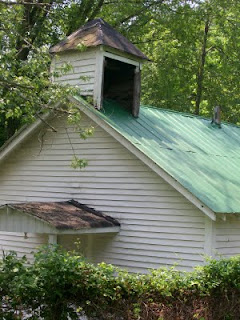 My genealogy days are thought to have started some 51 years ago while playing hide and seek in Granny Ewen's closet. [See post "50 Years of Genealogy", July 7, 2010.] That was until I found this picture of my brother and me at Nada cemetery standing with Granny Ewen. It seems that I was about four, and my brother about six years of age. Granny has her arm around Henry's right shoulder, and I have my hands folded respectfully. Henry is holding the flowers which I guess were to be placed among those already evident. It must have been mid-summer since our summer attire was in place, [See post "Shorts and Nothing Else", Dec. 30, 2010.], except we needed to wear shoes so we didn't mess our feet up. This might even had been that same summer we had our picture taken on Danny!
My genealogy days are thought to have started some 51 years ago while playing hide and seek in Granny Ewen's closet. [See post "50 Years of Genealogy", July 7, 2010.] That was until I found this picture of my brother and me at Nada cemetery standing with Granny Ewen. It seems that I was about four, and my brother about six years of age. Granny has her arm around Henry's right shoulder, and I have my hands folded respectfully. Henry is holding the flowers which I guess were to be placed among those already evident. It must have been mid-summer since our summer attire was in place, [See post "Shorts and Nothing Else", Dec. 30, 2010.], except we needed to wear shoes so we didn't mess our feet up. This might even had been that same summer we had our picture taken on Danny! We must have been facing the head stone of George Washington Ewen. I do remember seeing a headstone with some kind of funny markings on it. This must have been the Mason's symbol faintly seen now in the picture to the right. The headstone clearly shows the wear and tear of time, and vandals, since it was placed more than a century ago. This is also where three daughters of Granny had been buried so we could have been saying hello to them. I certainly seem to be standing stiffly which means I must have been unsure as to what to do around these dead folks. Making silly faces would not seem quite right. [Pictures of the head stones are shown in the post "Nada cemetery", Aug. 14, 2010.]
We must have been facing the head stone of George Washington Ewen. I do remember seeing a headstone with some kind of funny markings on it. This must have been the Mason's symbol faintly seen now in the picture to the right. The headstone clearly shows the wear and tear of time, and vandals, since it was placed more than a century ago. This is also where three daughters of Granny had been buried so we could have been saying hello to them. I certainly seem to be standing stiffly which means I must have been unsure as to what to do around these dead folks. Making silly faces would not seem quite right. [Pictures of the head stones are shown in the post "Nada cemetery", Aug. 14, 2010.]The last picture shows the church that was standing behind our backs. This picture taken at just about the same angle, and just about the same position. It was our family's Sunday go to meeting church shown in the post of January 25, 2011. The fence line has grown, and crowded out the front. It seems that many other things have crowded out this small structure used by my family so many years ago. Only the graves remain.
George Washington Ewen and his wife Susan Francis (nee Cole) are buried there...just beyond the gate.

My brother and I were there some 50 years ago...saying hello.







